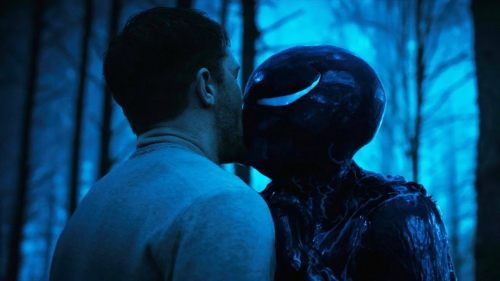Queer Underworld: VAMPYROS LESBOS (1971)
Vampyros Lesbos is a German exploitation film that is relatively unremembered save for its psychedelic score that would find a resurgence in popularity during the 1990s, but at the time of its release it was a popular staple of European cinemas for pretty much exactly the reason you would expect: Vampyros Lesbos is basically the softest of softcore pornography, but with the added hook that all the sex portrayed onscreen is between two women. It would be generous to consider its plot convoluted, since it exists primarily to get our innocent protagonist and vampiric antagonist simultaneously naked again and again, but it’s also such a thinly sketched film that you’d be forgiven for losing track of characters, motivations, or even whether someone is or is not in the thrall of the vampire’s curse, as ambiguously defined as that is. This is clearly a film made by heterosexual men, for heterosexual men, with the express purpose of titillation. But that doesn’t mean the film is without value to the kind of women the film exploits for that titillation.
The plot, for what its, focuses on a legal worker named Linda Westinghouse (Ewa Strömberg) who visits a nightclub burlesque act, performed by the Countess Nadine Carody (Soledad Miranda). Linda’s boyfriend Omar (Andrés Monales) notices how enraptured she is with the performance, though he clearly doesn’t understand her attraction to the spectacle. Linda then starts having dreams of this mysterious dancer, who calls her to her island home. Linda seeks out the countess under the pretense of settling estate issues, but along the way meets a mysterious man named Memmet (Jesús Franco, also director and co-writer of the film), who warns her to stay away from the island. However, when she discovers Memmet torturing a woman in his basement, she flees to the island anyway.
What follows is a pretty standard story of vampiric seduction as Nadine discovers that she is addicted to Linda’s blood, and Linda finds herself unsuccessfully resisting Nadine’s thrall with no memory of their sexual encounters after they happen. What’s more interesting from a thematic standpoint are the subplots, revolving around an institutionalized woman named Agra (Heidrun Kussin), her caretaker Dr. Seward (Dennis Price), and the aforementioned Memmet. Agra has persistent dreams and fantasies about a mistress calling out to her, which Dr. Seward purports to treat as delusions. However, as Dr. Seward wakes an unconscious Linda who newly arrived in his care, it becomes clear that he doesn’t really think the hypnotic influence of this mistress is fake. In fact, he tells Linda how to kill a vampire, taking their existence as fact. An eventual confrontation between Nadine and the doctor reveals that he wishes to hold the same kind of vampiric sway over people, which I think says something about how the people making this film see lesbians.
Namely, within the unconscious subtext of this film, lesbianism is seen as a threat to heterosexual masculinity. It’s something that straight men are drawn to as a sexual attraction, and it’s something that may even be exploited for male titillation, but it’s ultimately a threat to their perceived ability to attract women. After all, why should a woman be with a man when she’s clearly enjoying herself so much with another woman? You see this play out in Dr. Seward’s envy of Nadine’s power, but you also see it in Memmet’s abduction and torture of women he believes to have been brought under Nadine’s influence. Memmet eventually captures Linda and reveals that Agra is his wife, though you would never know it from how Agra obsesses over her mistress. Memmet seems to believe that he is saving these enthralled women from his wife’s fate. The director’s choice to cast himself in this role feels telling, for even though Memmet is an obvious villain, he gives voice to a perspective that underlies the film’s blatant sexual purpose: lesbians may be exciting, but they are a threat to masculinity.
This theme is reinforced when Linda comes upon a weakened, blood-deprived Nadine, and rather than give her blood willingly, she instead bites Nadine’s neck before killing her with a sharpened pole through the eye. The intentional reading of this scene is that Linda overcame her unholy sexual desires to slay her temptress, returning to the arms of her boyfriend, but I want to take a step back and look at this film through a queerer lens. Remember that in 1970 there were very few films that depicted lesbianism in any fashion, exploitatively or not. Simply acknowledging the existence of same-sex relationships in a film was novel, and though the film subtextually reinforces the patriarchal heterosexual status quo, its text is purely a sensual exploration of lesbian sexuality. It may be offered under the barest pretext of elevated pornography, but it’s still a story of sexual awakening and desire, albeit through a lens of fantastical horror and male gaze.
This is, admittedly, a pretty shallow justification for considering the film in any way sexually progressive. But the thing to remember about sexual awakening, both for straight and queer folks, is that it is often spurned on by exposure to eroticism and often pornography. Sexuality between two women may be in films for marketability and reinforcement of straight male consumption, but women are still exposed to that sensuality and potentially have something to gain or discover in themselves from that exposure. It’s through exploitation and pornography that many queer folks even realize that they aren’t straight or cisgender, through finding something erotic in an eroticism not explicitly targeted at them.
I wanted to talk about Vampyros Lesbos, not because it’s a particularly important film in the cinematic canon or even because it’s a particularly good film, but because it really is neither. It’s a sleazy little film that had a moment of popularity, and even though it is founded on a basis of exploitation, it still holds value as an artifact of its era. While straight men may have left the theater aroused and reaffirmed that their own girlfriends were safe from lesbian seduction, lesbians might have found a kernel of truth in the moment where Nadine kills Dr. Seward for his arrogance, or in the film’s final moments, where Linda, against Omar’s wishes, refuses to forget her encounters with Nadine. Vampyros Lesbos is worth talking about because, even though it wasn’t made with a queer audience in mind, it still had something to say to an audience starved for content, and even amongst the false equivalency of lesbianism with monstrosity, there’s still an affirmation of existence, the reality of lesbian desire. It may not be much, and it would certainly be pitiful by today’s standards, but that affirmation still holds value.



